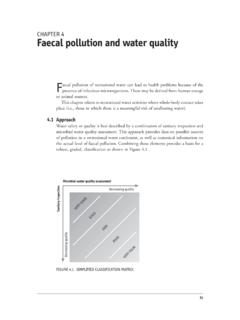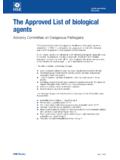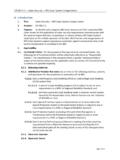Transcription of Classifying Educational Programmes - OECD.org - …
1 ClassifyingEducationalProgrammesManual for ISCED-97 Implementationin OECD Countries1999 EditionORGANISATION FOR ECONOMIC CO-OPERATION AND DEVELOPMENT3 ForewordAs the structure of Educational systems varies widely between countries, a framework to collectand report data on Educational Programmes with a similar level of Educational content is a clearprerequisite for the production of internationally comparable education statistics and indicators. In1997, a revised International Standard Classification of Education (ISCED-97) was adopted by theUNESCO General Conference. This multi-dimensional framework has the potential to greatly improvethe comparability of education statistics as data collected under this framework will allow for thecomparison of Educational Programmes with similar levels of Educational content and to betterreflect complex Educational pathways in the OECD indicators.
2 The purpose of Classifying EducationalProgrammes: Manual for ISCED-97 Implementation in OECD Countries is to give clear guidance toOECD countries on how to implement the ISCED-97 framework in international data , this manual summarises the rationale for the revised ISCED framework, as well as the definingcharacteristics of the ISCED-97 levels and cross-classification categories for OECD countries,emphasising the criteria that define the boundaries between Educational levels. The methodology forapplying ISCED-97 in the national context that is described in this manual has been developed andagreed upon by the OECD/INES Technical Group, a working group on education statistics and indicatorsrepresenting 29 OECD countries. The OECD Secretariat has also worked closely with both EUROSTATand UNESCO to ensure that ISCED-97 will be implemented in a uniform manner across all Programmes in OECD countries that meet specific classification criteria are also presented asexamples of how the criteria can be properly , the manual contains detailed proposals for the allocation of national educationalprogrammes to ISCED-97 levels for all 29 OECD countries in a tabular format.
3 These proposals havebeen developed by Member countries, in consultation with the OECD Secretariat, and represent thestarting point for a process of consultation within the OECD/INES Technical Group, with the aim ofworking towards an internationally agreed upon allocation of national Educational programme toISCED-97 in the OECD. The national programme allocations presented here have been reviewed andapproved by the OECD/INES Technical Group and will form the basis of data reporting in the1999 UNESCO/OECD/EUROSTAT (UOE) Data Collection on Education Statistics. These countryallocations will also guide the implementation of ISCED-97 in all future OECD data collections,including the alignment of levels of Educational attainment data collected in national Labour ForceSurveys and the categorisation of both students Educational aspirations and teachers educationalqualifications in the programme for International Student Assessment (PISA).
4 4 MANUAL FOR ISCED-97 IMPLEMENTATION IN OECD COUNTRIES 1999 EDITIONThe primary goal of OECD s work in the ISCED-97 implementation process is that the allocationof national education Programmes to the revised ISCED framework be perfectly transparent and jointlyagreed upon by all Member countries. The Technical Group will continue to serve as a forum fordiscussing and evaluating individual country s ISCED-97 allocations. Particular programme allocationsthat do not match the criteria laid out in this manual, and thereby do not lead to comparable educationstatistics, will be brought up and discussed in the Technical Group. In cases where this manual doesnot make it clear how a programme with particular characteristics should be mapped to ISCED-97,proposals for modifying the manual will be developed and discussed within the Technical Group.
5 Theimplementation of ISCED will be both an iterative and interactive process, with both Member countriesand international organisations reviewing countries assignments of Programmes to ISCED categoriesand recommending adjustments to enhance international OECD foresees that the implementation instructions for ISCED-97, as well as ISCED itself,will need to be updated as education systems evolve and additional comparability issues are publication of this manual is an important step forward in a long-term consultative process designedto improve the comparability of Educational book is published on the responsibility of the Secretary-General of the of 7 COVERAGE AND STRUCTURE OF ISCED-97 .. 11 OTHER DIMENSIONS NOT ACCOUNTED FOR ISCED-97 .. 17 LEVEL STRUCTURE OF ISCED-97 AND CORRESPONDING CLASSIFICATION 21 ISCED 0 PRE-PRIMARY LEVEL OF 25 ISCED 1 PRIMARY LEVEL OF 29 ISCED 2 LOWER SECONDARY LEVEL OF 33 ISCED 3 UPPER SECONDARY LEVEL OF 39 ISCED 4 POST-SECONDARY 47 ISCED 5 FIRST STAGE OF TERTIARY 51 ISCED 6 SECOND STAGE OF TERTIARY 63 PROPOSED ALLOCATION OF NATIONAL Educational Programmes TO ISCED-97.
6 656 MANUAL FOR ISCED-97 IMPLEMENTATION IN OECD COUNTRIES 1999 EDITIONISCED-97 levels for each OECD 68 BELGIUM (FLEMISH COMMUNITY) .. 70 BELGIUM (FRENCH COMMUNITY) .. 76 CZECH 100 NEW 111 UNITED 112 UNITED The need to revise ISCEDThe structure of education and learning systems has changed dramatically over the last 25 increasing complexity of education systems, often reflecting more choice both between types ofprogrammes and modes of attendance, has imposed new difficulties for the international comparabilityof education statistics. New forms of education have appeared and the boundaries that have traditionallyseparated different types of education Programmes have blurred. Many of these changes could nolonger be adequately reflected in data collected under the original International Standard Classificationof Education (ISCED), which was first implemented in the mid-1970s.
7 These structural changes innational education systems have driven the need to revise ISCED, the classification system underlyingthe mapping of national data to policy-oriented international indicators of education is significant for Educational policy making in OECD countries, as it provides the essentialbasis for collecting the data underlying OECD s set of policy-guided indicators on education provides the metric through which the level of Educational content underlying different educationalprogrammes is assessed and aligned. Although the INES project (Indicators of Education Systems)has advanced significantly in developing internationally comparable education indicators, a conceptuallyadequate and operational definition of levels of education has been the essential missing element,without which the usefulness of the indicator set for policy purposes is compromised.
8 Particularlyaffected by the current problems of ISCED are indicators on costs and resources, graduation rates andlevel of Educational attainment in the population and indicators on labour market purpose of ISCED is to provide an integrated and consistent statistical framework for thecollection and reporting of internationally comparable education statistics. The coverage of ISCED-97extends to all organised and sustained learning opportunities for children, youth and adults, includingthose with special Educational needs, irrespective of the institutions or organisations providing them orthe form in which they are the remainder of this section the key problems with the original ISCED framework (referred toin this document as ISCED-76) are summarised and OECD s priorities for the revised ISCED frameworkare reviewed. As the revised ISCED framework is broadly compatible with OECD s priorities, theultimate success of the ISCED revision rests on the uniformity of its implementation across Membercountries.
9 This manual provides a methodology for the uniform implementation of the revised ISCED framework in OECD FOR ISCED-97 IMPLEMENTATION IN OECD COUNTRIES 1999 EDITION The necessary components of a revised ISCEDAn international taxonomy for Classifying levels of education must take variations in nationaleducation structures explicitly into account. The objective of any taxonomy is to represent diversestructures satisfactorily within a single set of international categories. How such variations in structuresare handled by the classification system is critically important for achievement of the comparabilitygoal. A lack of comparability between countries in various education indicators was introduced in datacollected under ISCED-76 for three main reasons: 1) the ISCED categories did not adequately reflectthe diversity in structure of national education systems; 2) ISCED provided few guidelines for how toclassify Programmes that did not neatly fit into the taxonomy framework; and 3) countries were left tointerpret the ISCED level taxonomy on their each country deciding separately how to portray its system in terms of ISCED levels, theresponses have been of two main kinds: some countries simply identified their own national institutionalstages with seemingly corresponding ISCED categories, without consideration of the starting pointsor lengths of Programmes .
10 Others have deviated deliberately from national structures in attempts toconform their statistics at least partly to the ISCED model. Not surprisingly, given the lack of a co-ordinating mechanism, these modes of response have not always yielded internationally consistentprogramme resolve this unsatisfactory situation, is critical that explicit and detailed operational specificationsbecome an integral part of the revised ISCED framework that is, inseparable from the basic specific instructions that are internationally agreed upon, a particular country, despite the bestof intentions, will not be in a position to determine whether its methods of assigning Programmes tointernational categories are compatible with those of other is critical that any framework used for empirically describing national Educational systems becapable of reflecting existing variations and complexities.















